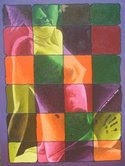
.JPG)
.JPG)
.JPG)

ABSTRACT.
This highly developed textiles form has transcends many culture and individuals. Adire, tie and dye over the years has become a viable vacation for educated men and women who now adapt to the latest technologies to develop new designs suitable and befitting all occasions to meet international standard.
Over the years, Adire has witnessed tremendous metamorphosis. The commonly known Adire comes in yards, 5 yards or more, of which the textile designers reflect their thoughts and ideas in the patterns they make on the fabric. Today, the textile designers incorporate print of intricate design with the use of rich and vibrant hues of opaque inks. The print gives the Adire a rich elaborate effect, making it look close to a painting piece. The end product are adopted into curtains, coverings for cushion chairs, throw pillow case, table cloth and the popular one, a ready-to-wear outfits.
The fad of this wearable art from Abeokuta is fast growing and gaining popularity. It is traditional and modern, elaborate and elegant with a great feel of ethnicity.
Some of the Artist that are trending the part of this new trade of Art are wilkor Creations, dacosta prints, duduethnikz among many others. Their works could be access through the links below.
www.artwanted.com/dacosta
The production of Adire textile is done in two ways in which both are resist methods of dying a pattern on a fabric. A part of the cloth is protected before it is immersed into the dye bath. The resisting agent, such as rafia or cotton thread resists the dye so as not to penetrate into the resisted areas. This is what the Egbas called “ONIKO”. Some patterns are stitched with a needle and thread which is called “ALABERE”.
The second method is called, “ELEKO”. The method is achieved on the fabric with application of starch paste made from cassava flour. This starch resists the dye from penetrating through the cloth. The starch pastes are applied with brush or feather on the surface of the fabric or through a stencil that has been cut into a design. It will be left to dry for a while under the sun before it is immersed into a dye solution.
The fabrics are taken to the tailor before working on it. The sown fabrics are immersed into the dye solution of the artist choice of colour. The next step after the dying is to spread it on a printing table for the printing process to commence.Afterwards, opaque ink is applied on the printing screen and placed on top of the fabric, squeegee is used to spread the ink along the surface of the screen.
The branding and packaging of the Adire in a ready-to-wear content is a plus to its accessibility and patronage in the society, thus making it prominent.
Meanwhile, the artists are strongly advice to use good and original materials to ensure a piece that is fast and durable. I hope one day to see this form of Art being paraded at the big event of fashion shows in Milan London, Paris, Tokyo, and New York.………………………………………………………………………………………………………………………………………………...The writer is a painter and a textile artist. He could be contacted for more expository on the subject or for practical presentation.
ADENIYI OLUSEGUN MICHAEL +234 802 406 9722, www.artwanted.com/adeniyi , aom3kk@gmail.com
































No comments:
Post a Comment